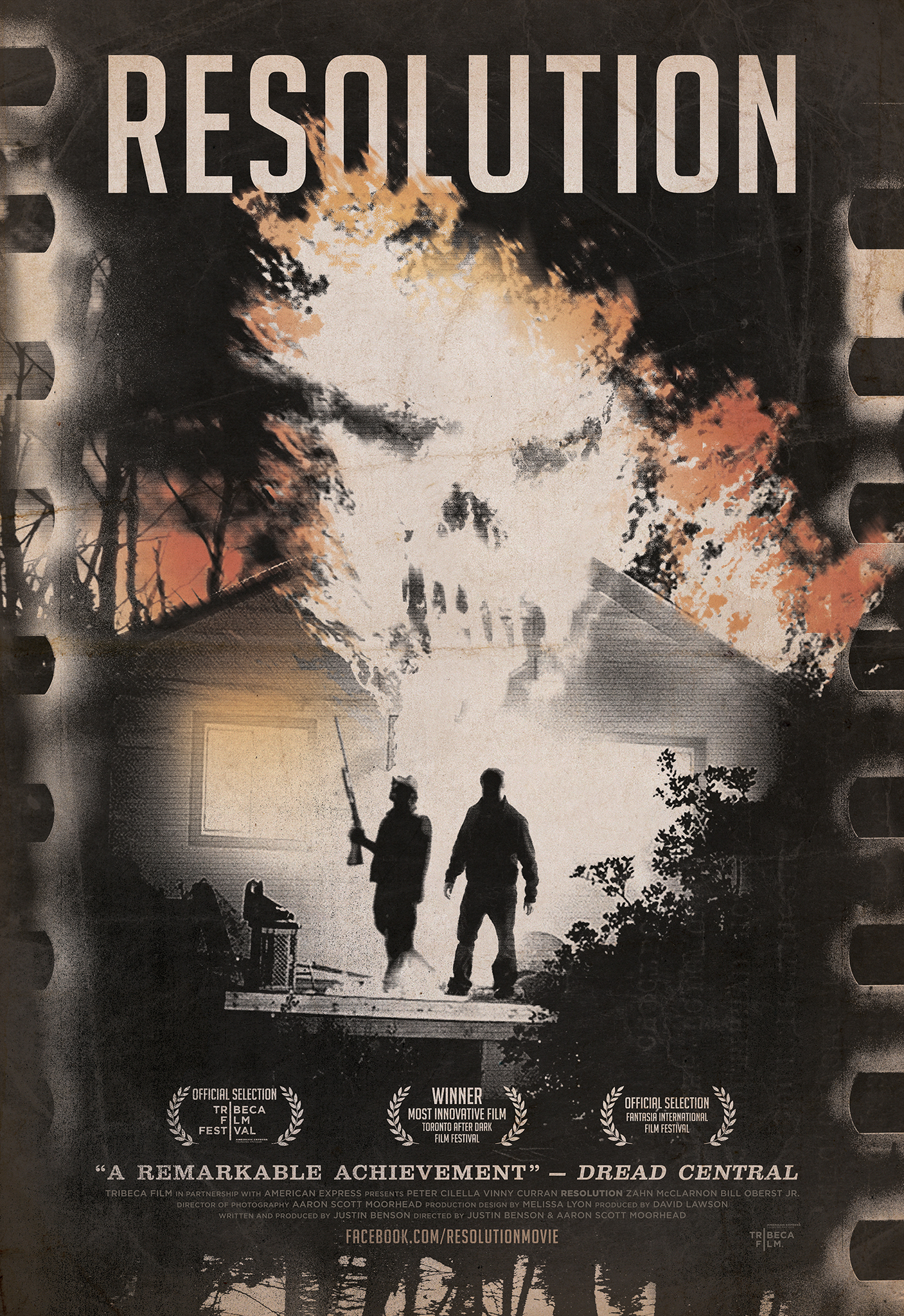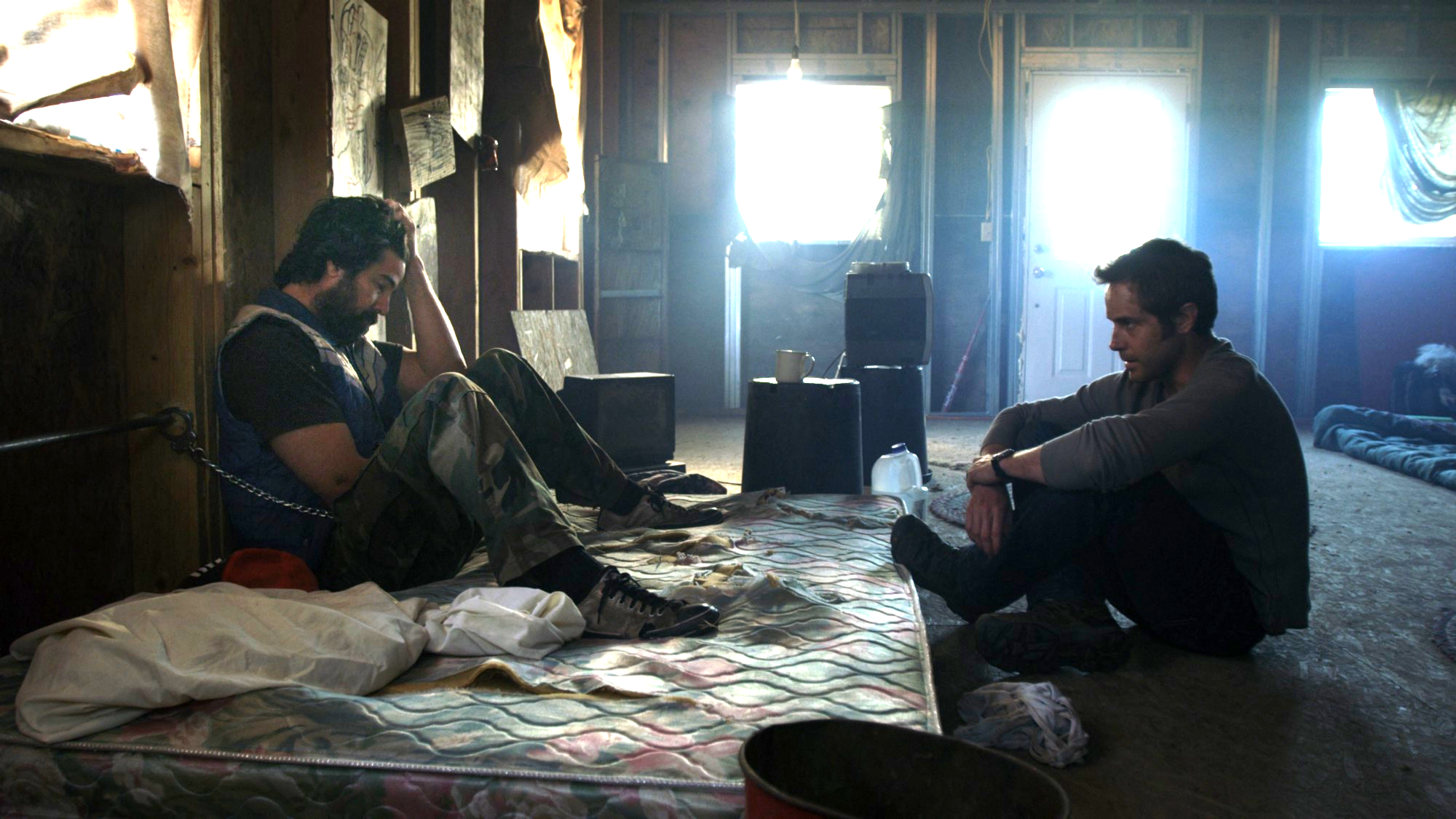

“How does an isolated tribesman in Ecuador know the difference between an alien, an angel, and a ghost?”
Spinning a tale of cosmic horror around a personal story of a teetering childhood friendship, Resolution boldly announces the arrival of first-timers Justin Benson and Aaron Moorhead. Though the micro-budget debut is occasionally awkward as it shuffles between various genre stylings, it effectively does it’s hair-raising routine without losing touch of the human element at its center. It zig-zags from curse-laden mumblecore to crime drama to psycho-horror, culminating in an ambiguous loose thread that the pair would pick up five years later with The Endless. It’s a slow burner that perhaps would have benefitted from a shorter runtime, but the crafty construction gives rise to a satisfying sense of foreboding that is ultimately rewarded with a spine-tingling conclusion.
The film begins with Mike (Peter Cilella) traveling to the California hinterland to force his friend Chris (Vinny Curran) to detox for a week. Shacked up in a dilapidated cabin in the middle of a sparsely populated wooded region overlapping an Indian reservation—we are way out in the boondocks—Chris is strung out, erratic, and delusional. When Mike arrives, Chris is firing clips of handgun ammunition into the trees at some birds that he imagines are harassing him. It’s unclear if the birds even exist and Chris freely gestures with his hands as if he is not holding a loaded gun. At first, Mike shows tender concern for his friend, but at the first opportunity he shifts to tough love—tasing Chris and handcuffing him to a pipe where he’ll spend the majority of the film. While Chris begs for drugs, death, and food and poops in a bucket, Mike tries to solve a mystery that gradually escalates as the clues become more and more sinister.
The bond between Mike and Chris is something that Resolution could not do without. To my understanding, the cosmic horror angle was the seed idea that Benson and Moorhead built around, with the detox storyline added later to flesh out the pair’s dynamic and force a timeline onto the events (it takes about a week to detox). But I find that their banter, references to past events, and authentic relationship are indispensable. Curran, specifically, appears to have been a joy on set and I wouldn’t be surprised to learn that much of his dialogue was improvised. There’s a serious deluge of f-bombs, but his charisma and the comedic chemistry of the two leads give the film a solid lift.

While the pacing is suspect, there is a palpable sense of danger present in the remote countryside. It reminds me of the murky backwoods horror style of David Lynch, though noticeably more self-conscious. Mike finds pictures, old film, a VHS tape, a book, a CD, wood carvings—most with impossible contents. At first, the clues are suggestive of a sinister prank, but they are eventually revealed to be of supernatural origin. Chris even denies sending the alarming video that spurred Mike’s intervention in the first place. The gradual investigation of these clues is where Resolution loses some of its steam. The clues themselves are interesting, but there is a lot of Mike wandering around the area by himself, vaguely heading in the direction suggested by each new clue. E.g. he finds the book in the woods, and takes it back to the library, where he finds another clue; he matches a landscape photo to a real landscape and finds the tape next to a gravestone. It’s a little bit tedious but they sufficiently mix up locations (caves, thrift stores, abandoned sheds, etc.) that it doesn’t get too dry.
Interspersing Mike’s investigation is his ongoing battle of wills with Chris, who goes through the gamut of withdrawal symptoms, even trying to slice his wrist with a broken coffee cup. There are also tons of red herrings, especially if you consider that all the tactile clues placed in Mike’s path by the entity are there just to mess with him. But Mike also crosses paths with a slew of oddballs—addicts, escaped mental patients, reclusive researchers, and UFO cultists, all of which appear to be potentially important, but are not. The cultists are of note because they are portrayed by Benson in Moorhead. Their scene in Resolution is only about a minute long, but they would reprise these roles as the main characters of The Endless.

Mike’s spookiest encounter occurs when he hikes out to a trailer—parked at a gorgeous overlook—to inform its owner that his dog was killed. Byron (Bill Oberst Jr.), a French researcher who has been there for thirty years, invites Mike in for tea. He smokes an unknown plant (which would also return in The Endless) and philosophizes about the entity haunting the region. In his estimation, it does not truly wish anyone ill. It merely wishes to witness a good story, one with a beginning, middle, and end. He holds up a mirror to Michael, creating an endless series of successively smaller images, disappearing into a little infinity.
If we want to get all postmodern in the analysis, we could substitute ourselves for the entity—trying to will the characters to do certain things, desiring a solid dramatic arc, favoring certain outcomes. The clues that Mike receives indicate a preferred route for the characters to follow—almost like the spirit-bubbles in Donnie Darko—but all those red herrings are potential alternatives. This notion is supported further by not only keeping the entity off screen but allowing us to witness events through its eyes. The early disembodied POV shots recall countless similar shots from slasher flicks. Accompanied by artificial lens flare and crackling film reel, we can’t help but believe there is something actually watching them, even when we know there is no one physically present. In the film’s final scene, when Mike and Chris come face to face with the entity at last, Mike asks, “Can we try it another way?” as if to acknowledge that their actions were not satisfactory. A number of clues, from Chris’s late apology to Byron’s talk of endless membranes in the sky, indicate what is about to happen. The film ends, but it is implied that Mike and Chris will now have a chance to redo their rehearsal for the entity.

The best parts of Resolution are saved for its climax, when Chris finally believes that Mike is not pulling his leg, and Mike becomes convinced that the mystery he is investigating could not have been orchestrated by a human. At this point, the entity makes its supernaturality apparent. It does this by turning on a projector and throwing up an image of Chris’s corpse in a funeral casket. When Mike tries to replay the video that Chris sent him in the film’s opening scene, it is different now—instead of Chris shooting guns and shouting, the video replays their conversations from minutes earlier. It then fast forwards itself into the future to show the pair being beaten to death by two other drug addicts that Chris ripped off. In a film that chose to avoid jump scares, this is about as close as you’ll get to one, but instead of being momentarily startled, you’ll be in a creeped out state for quite a while.
Resolution is the kind of film that every aspiring filmmaker should be encouraged to make—minuscule budget, small cast, creative use of insinuation so that it seems bigger than it is. Rather than spell things out, it offers a bit of a Rorschach image for us to ponder and possibly interpret. Using the buddy comedy as a jumping off point, the filmmakers effectively provoke questions of eschatology and infinity. They achieved all of this with $20k. I’ll take some more like this, please.